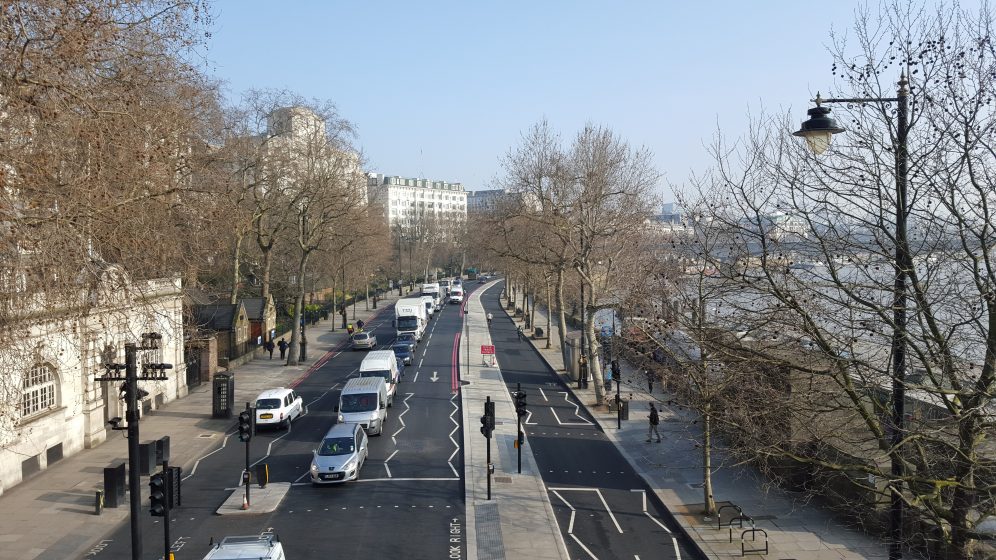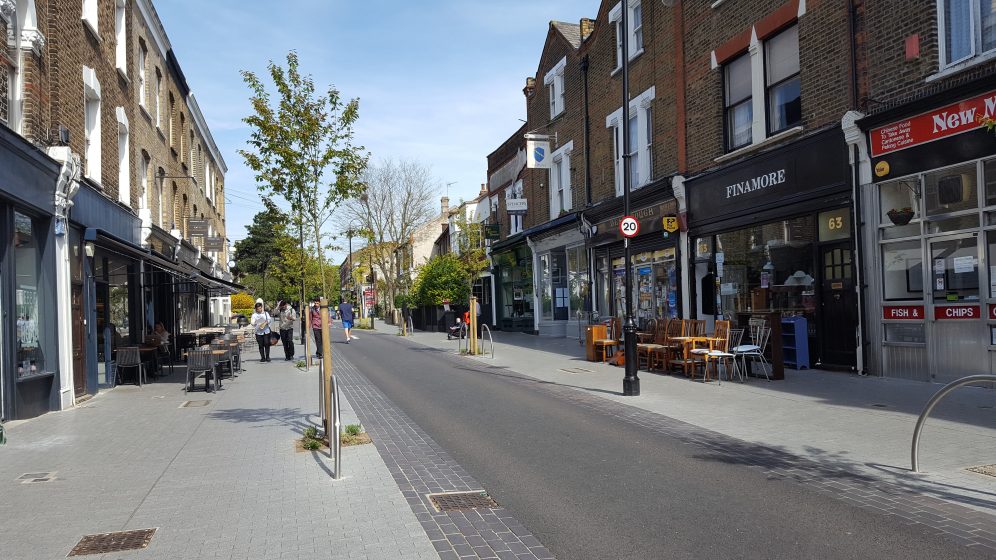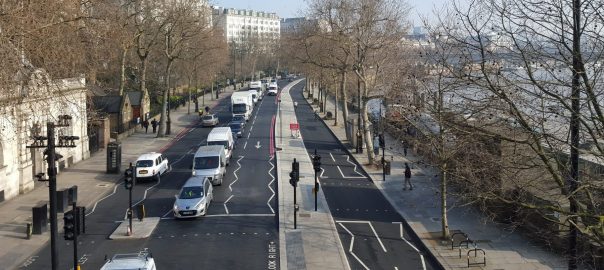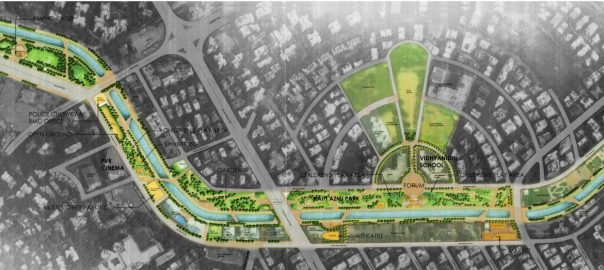The case for cycling in cities could not be more obvious: it is an emission-free, noise-free, healthy, cheap, accessible mode of transport. However, there is a lot more to promoting and planning for cycling, particularly in terms of understanding the politics, identities, and cultures associated with it—not just at a country level, but within each city and even district. To illustrate this point, I will use London as a case study. There have recently been heated controversies related to urban cycling schemes which shed light on the complexities involved with promoting cycling specifically, and active, sustainable transport more generally.
Cycling is a socially complex mode of sustainable and active transport. Its successful implementation necessitates community input.
Background
It is may be helpful to begin with some background on planning for active transport modes such as walking and cycling. Globally, the 1980s and early 1990s witnessed a growth of interest in these modes from a planning and urban design perspective, particularly given the rise in environmental awareness and the sustainable development agenda (see references below for further details). The late 1990s and 2000s also saw a surge of research in this area from the public health community, which was interested in promoting physical activity and in understanding the influence of the physical environment on people’s travel choices and behaviours. This literature was detailed and provided valuable insights into interventions that could promote active transport. However, this body of work focused on epidemiological research methods and did not sufficiently address social perceptions and cultural identities related to walking and cycling. More socially-based research has recently emerged which is filling in some of these gaps.
One such study is the research led by Professor Colin Pooley at the University of Lancaster, England. He examined walking and cycling behaviours and attitudes in four English towns (Leeds, Leicester, Worcester, Lancaster). In addition to often-cited barriers like perceived safety risks of walking and cycling in the absence of segregated pathways, the study identified a general perception that walking and cycling were “abnormal” transport modes (as opposed to car travel), even for short distance trips. They argue that these factors can explain the substantially lower levels of cycling in the UK (1.5 percent of all trips), compared to neighbouring countries such as Germany (10 percent), Denmark (18 percent), and the Netherlands (26 percent). The policy recommendations from this study stressed the importance of tackling the broader social and cultural barriers to walking and cycling, in addition to providing the appropriate infrastructure.
London
In London, cycling has been a political topic since the 1980s when pro-cycling policies were introduced by Ken Livingstone (the Labour Party) after winning the Greater London Council (GLC) elections in 1981. Conservative borough (district) councils in London such as Kensington and Chelsea greatly opposed such schemes, partly due to political antagonism and partly due to a belief by their transport engineers that catering for cycling was not important. As soon as the GLC was abolished in 1986, Kensington and Chelsea council removed the cycle lanes they had been forced to implement.

Since then, cycling has regained political importance in London; the (Conservative) mayor called for a Cycling Revolution in 2010, claimed that cycling is arguably “the single most important tool for making London the best big city in the world”, and released a Vision for Cycling in 2013 . It has recently been argued that the promotion and practice of utility cycling in London can be conceptualised as part of a broader neoliberalisation processes, whereby what is being promoted is a “narrow productivist framing of cycling”, which focuses on shaping individuals as “entrepreneurs of the self”, for whom cycling will provide more efficient movement. This aligns with findings from research on social identities related to cycling in London published in 2010, which demonstrated that many London residents, particularly in inner London, associate cycling with independence, speed, and efficiency as well as with health benefits.
There are other discourses that shape the identity and culture of cycling in London. In his book One Less Car, Furness highlights how newspapers in London, particularly between 2005 and 2010, demonised cyclists for threatening the safety, freedom, mobility and way of life of car drivers. He sees this as an extension of the British “car driver as a victim” mentality promoted by the automobile industry. Another study noted that, in London, “cycling is disproportionately an activity of affluent, White men” who cultivate a particular “assertive” style which is “less appealing to those with other class, gendered and ethnic identities”. They also suggest that the relative “invisibility” of Black and Asian cyclists reduces the appeal of cycling in these communities.
It is not entirely surprising, therefore, that while the share of cycling as a mode of transportation within a journey increased substantially among male residents of inner London, cycling’s overall share of journey stages in London remains at 2 percent, unchanged since it doubled in 2005 (when the attacks on the London public transport network occurred). In fact, the UK Department for Transport recently highlighted that there has been a decrease in the proportion of London adult residents who cycle at least once a month, compared to 2010.
Mini-Hollands Controversy
This brings us to the controversy that has recently arisen in two outer London boroughs (Waltham Forest and Enfield) related to the implementation of local cycling schemes. The schemes are part of Transport for London’s (TfL) Mini-Hollands programme, aimed primarily at encouraging more people in outer London to undertake short trips by bicycle rather than by car. Approved in 2014, the Enjoy Waltham Forest and Cycle Enfield plans are due to be completed by 2018. The plans were developed by the individual borough councils and include a range of physical interventions such as new segregated cycling lanes and pedestrianised areas, which will be funded by TfL. The plans do not generally extend to the provision of educational or behavioural change campaigns; however, they do recognise the importance of normalising cycling, particularly amongst women and ethnic minorities. Waltham Forest and Enfield both have high percentages of Asian and Black minorities (38 percent and 29 percent, respectively).
Despite this recognition, the schemes have been implemented hastily, with little consideration of how to broaden the appeal of cycling. Perhaps unsurprisingly, they are facing significant challenges from the local community, some members of which have formed anti-mini-Holland social media groups, started online petitions, taken to the streets to protest, and even filed a court case against their local council. While this opposition has garnered substantial coverage, the media and pro-cycling groups have tended to characterise protestors as fringe groups of “drivers” or “anti-cyclists”.

Comments on the online petitions provide a deeper insight into the cause of the protests and identity of protestors. The main contested issue in Waltham Forest is road closures limiting vehicle access on local residential and commercial streets. This has created congestion on other roads and has severely impacted access for less mobile residents such as the elderly and the disabled, as noted by many of the comments on the recent online petition. Signatories of the petition also lament the community divisions which the scheme has created, particularly along ethnicity and class lines. One of the comments also draws attention to the “patronising and polarising nature of the debate in which cyclists are painted as saints, single handedly saving the planet and the rest of us are dismissed as lazy, thoughtless and selfish, driving around in our gas-guzzling cars…”
In Enfield, the primary discontent seems to be with the introduction of a segregated cycle lane on a commercial street. The comments from petition signatories reflect the fact that many see cycling as a foreign identity and way of life, and not simply a transport option. “I believe that this ill-advised and indeed dangerous plan will disadvantage ALL road users other than a few cyclists. The demographic of this area is not one that will be taking to using bicycles in the future…” is an example of the comments included. This is a different discourse to that in Waltham Forest, where many of those in opposition to the scheme have insisted that they are for cycling and for safer cycling routes. Both Waltham Forest and Enfield petition signatories argue that the schemes have been implemented in an undemocratic and rushed fashion, without giving due to consideration to concerns by locals.
Interestingly, the third mini-Holland scheme, Kensington borough’s Go Cycle, did not face any community protests or vocal objections, although the scheme includes a number of cycle routes and the consultation process was not significantly different to the other two schemes. On the other hand, only 15 percent of Kingston’s population is Asian and Black. Furthermore, both Waltham Forest and Enfield are led by the Labour Party whereas Kingston is a stronghold of the Conservative Party.
Conclusion
In their book Cycling and Society, Horton, Rosen, and Cox make a very relevant comment, worth quoting in full: “Historically, geographically, socially and culturally, cycling is a complex and diverse practise. Yet it is increasingly promoted by national governments across the rich world as a simple, straightforward mode of mobility with a variety of beneficial effects.” They go on to suggest that cycling would be much more effectively promoted if policies were based on a better understanding of its complexity and diversity. The mini-Holland projects in London demonstrate that this is true at a city and even neighbourhood level as well as a national scale. Similar examples of politicised contestation of urban cycling schemes have been reported in other cities such as Toronto and Rio.
These examples reveal that simply introducing new physical realities (e.g. road closures, cycle lanes) overnight is not the way to promote sustainable and active transport in existing neighbourhoods, particularly for socially complex modes such as cycling. Furthermore, not all objections to cycling projects stem from ‘anti-cyclist’ attitudes, as demonstrated by the Waltham Forest case. Local communities may have other reasons to oppose active transport interventions, which should be carefully understood and addressed by planning authorities. Patronising and inflammatory discourse is never the answer. In addition, if the aim of urban policy makers is to reduce congestion, reduce emissions, and increase physical activity levels, then perhaps less politicised modes, such as walking, should be given more serious consideration.
Finally, just like any other planning intervention, it is inevitable that there will be winners and losers with planning for active transport. Transport planners know full well that effectively promoting alternative transport modes will require prioritising these modes over cars, thereby inconveniencing car users—at the very least. However, it is important for planner and policy makers to be conscious of social divisions and inequalities which may be worsened by ‘sustainable’ transport interventions, and to avoid such detrimental outcomes through more considered planning and implementation.
Huda Shaka
Dubai
References
Horton, D., Cox, P. and Rosen, P. (eds.), 2007. Cycling and society. Aldershot: Ashgate Publishing Limited.
McClintock, H. (ed.), 1992. The Bicycle and City Traffic: Principles and Practice, London: Belhaven Press.
Tolley, R., 1990. The greening of urban transport: planning for walking and cycling in Western cities. London: Belhaven Press.







Leave a Reply